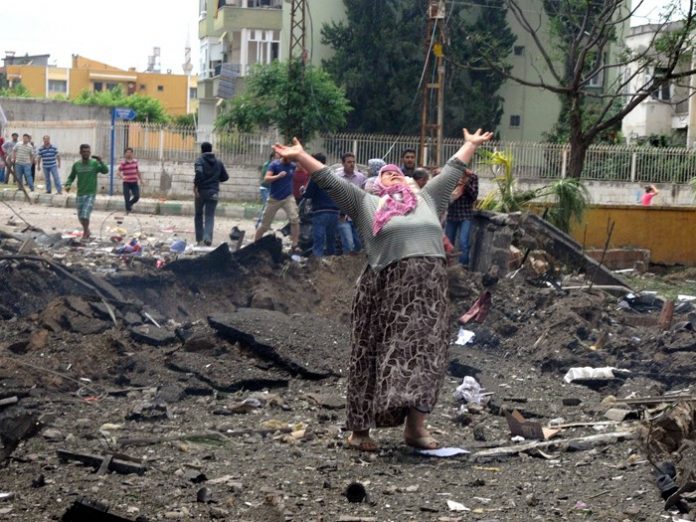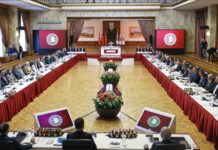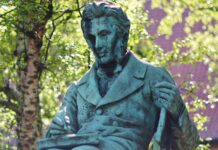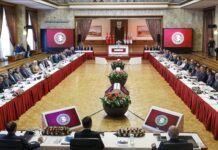From February 2012 to May 2013, Turkish politics seemed to be heading in a steadily positive direction. Despite the violence in Syria, the U.S. inaction in the face of the state-sponsored violence occurring there, and the beginning of refugee flows into Turkey, domestic Turkish politics remained calm. The Turkish government abandoned its attempts to persuade Bashar al-Assad to stop using violence against his own citizens and to carry out democratic reforms. Since then it has appeared that this created an opportunity for Gülen to attack the AKP from a different angle.
For about six months after an uprising against the al-Assad regime broke out, then-Foreign Minister Ahmet Davutoğlu made continued attempts to convince Damascus to take a different course, but counter-pressure from the U.S. administration as well as a lack of results eventually frustrated those efforts. Turkey switched to active opposition to the Syrian régime and openly began to host al-Assad’s opposition. That was in late 2011. By the middle of 2012, expectations were that al-Assad would be removed from power within months. However, events began to change direction towards the end of 2012 as first Iran and its regional proxies, and then Russia, became more involved in supporting the Syrian regime.
By early 2013, the number of Syrians in Turkey had reached the hundreds of thousands, and poverty-stricken refugees began to appear on Istanbul streets. In November 2012 and March 2013, the main Turkish opposition party, CHP, sent delegations to Damascus which met al-Assad despite the fact that al-Assad was by then personally responsible for the deaths of tens of thousands of his own citizens (1).
Then violence, occurring in Turkey but clearly sourced in the Syrian conflict, began to happen. On 11 May 2013 truck bombs exploded in Reyhanlı, a Turkish town on the Syrian border, killing more than fifty. The Syrian operative accused of masterminding the bombing appeared to have had a role in at least one of the meetings between al-Assad and the CHP (2). Furthermore, as Yıldıray Oğur later exposed in detail, police and gendarmes connected to Fethullah Gülen’s cult clearly facilitated the Reyhanlı bombings (3). All in all, everything pointed to the Reyhanlı bombing as having resulted from tacit collusion between al-Assad’s operatives and Gülen’s adherents.
But that was only the beginning. As everyone is aware, the Gezi Park protests (or riots, or commune) of May-July 2013 began during the last week of May 2013, triggered not so much by the threat to dig up a couple of trees in the park in order to re-construct a late-Ottoman military barracks (which would then be used as cultural events, museum, and souvenir-shopping space), but rather by a brutal police attack on the tents of the original environmentalist protesters that had been camping out in the park. In the wake of the July 2016 coup we learned that several high-ranking police officials who had been in key Istanbul posts in May 2013, as well as none other than Hüseyin Avni Mutlu, then governor of Istanbul (4) and therefore at the very top of the security chain of command, were all directly part of Gülen’s cult. This has suggested that police behavior at the beginning of the Gezi Park events may have been an intentional provocation aimed at creating social unrest. If so, then to that extent they were successful, but not to the point of ultimately overturning the AKP government.
Eventually the Gezi Park events were stifled as much by the protesters’ lack of organization or staying power as any other factor (including the final entry of the police into the park). Now, more than three years later, given that no lasting political movement emerged the Gezi protests’ main effect can be described as pure social trauma. Nevertheless they foreshadowed continued political crises.
In previous installments in this series of articles I have noted that while Gülen aimed at infiltrating key state institutions such as the judiciary, military, and police, most of his adherents seem to have been recruited through the education sector. At the time that I came to Turkey, Gülen’s involvement in the education sector was the most prominent, indeed virtually the only way that Gülen was known to Turkish society. Gülen’s regular schools were also private and emphatically for profit.
For at least a year before November 2013, I had developed the expectation that the AKP would take action to curb Turkish private education’s cram school sector. My reasons had to do with the AKP’s political rhetoric, and may surprise those who haven’t followed its political decision-making over the years.
That the Turkish education system has deeply-ingrained problems is common knowledge, and a constant source of complaints. Turkish cram schools (dersanes) emerged in the 1990s as a stop-gap inspired by the contradiction between Turkey’s chronically weak public education and the stringent testing necessary to get into state universities (private universities only became common in Turkey from the end of the 90s). These cram schools had subsequently turned into a massive sector that not only made large amounts of money and employed tens of thousands of staff, but also perpetuated inequality because those who could pay the most invariably benefited from the best exam preparation. The AKP is a populist political party, and has presented itself as a party that would provide opportunities for all people in Turkish society, not just those who could afford the best education (5). The AKP’s populism, coupled with a stated goal of ameliorating Turkey’s educational difficulties, led logically to the conclusion that sooner or later they would do something about cram schools as unjust (as they truly are) for much of the Turkish population.
This is why following the AKP’s political rhetoric on a daily basis made it clear to me that drastic action would eventually be taken towards cram schools. For that reason, I was not surprised at all when, in November 2013, the AKP moved to close down the cram school sector. What I didn’t expect was the vehemence, and ultimately violence, of the Gülenist response.
NOTES
(1) http://www.sozcu.com.tr/2012/gunun-icinden/cuneyt-unal-ozgur-119008/; http://t24.com.tr/haber/chpli-vekiller-esedle-gorustu,225227
(2) http://www.milliyet.com.tr/chp-nin-basini-yakacak-o-kare/siyaset/detay/1715148/default.htm
(3) https://serbestiyet.com/yazarlar/yildiray-ogur/reyhanli-katliami-bagira-bagira-gelmis-165870
(4) http://www.hurriyet.com.tr/eski-istanbul-valisi-huseyin-avni-mutlu-gozaltinda-40170091
(5) See, for example: http://www.sabah.com.tr/gundem/2013/11/21/basbakandan-ilk-dershane-aciklamasi-kararliyiz#













